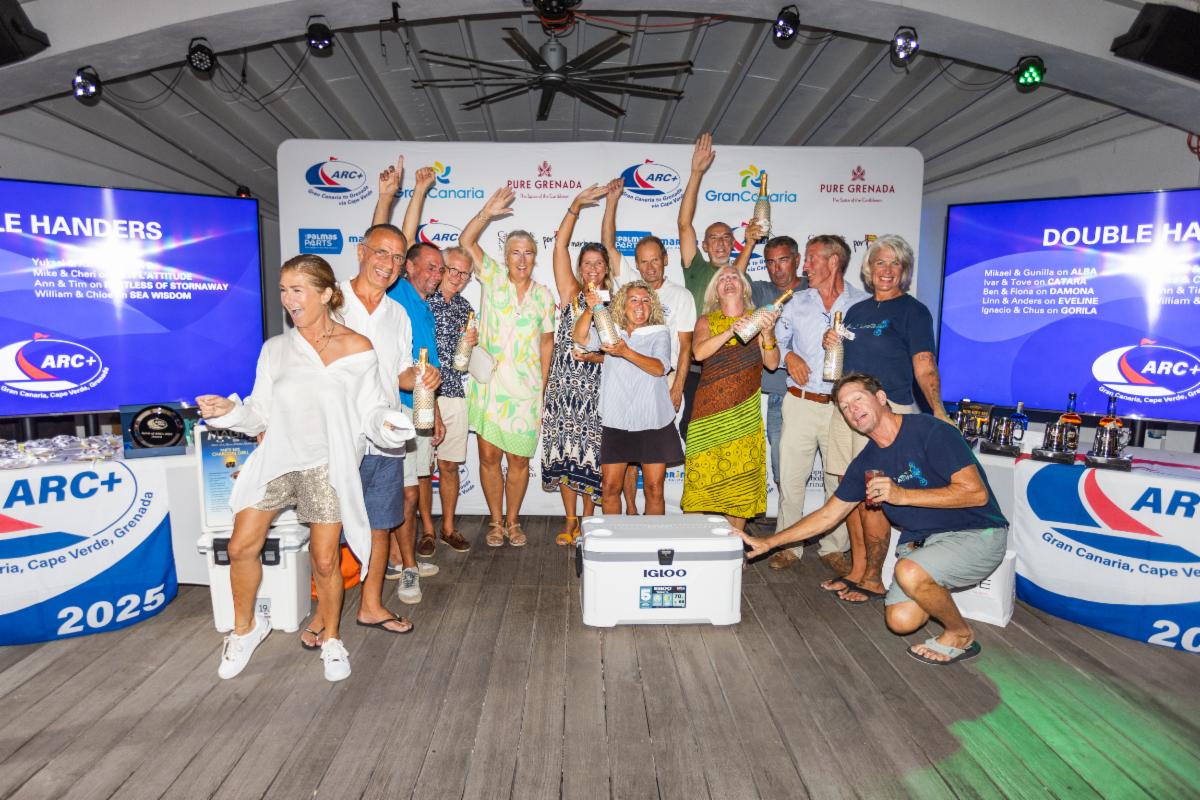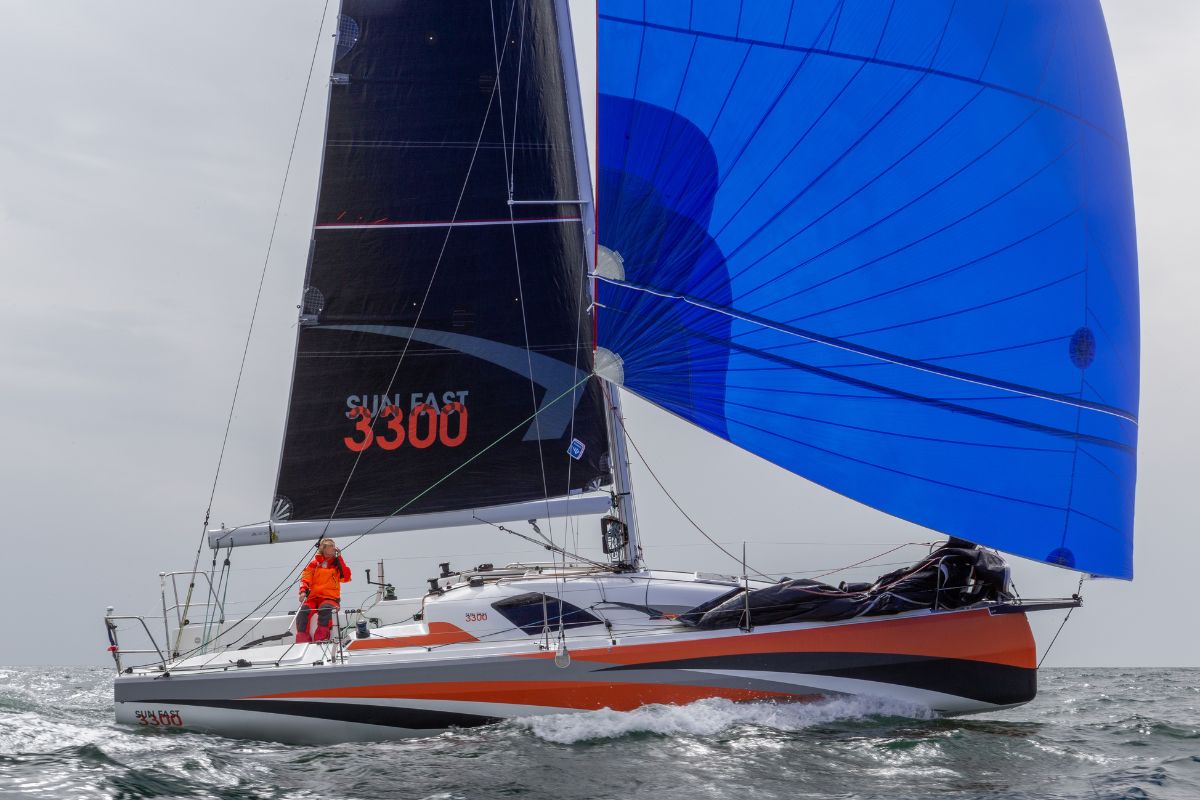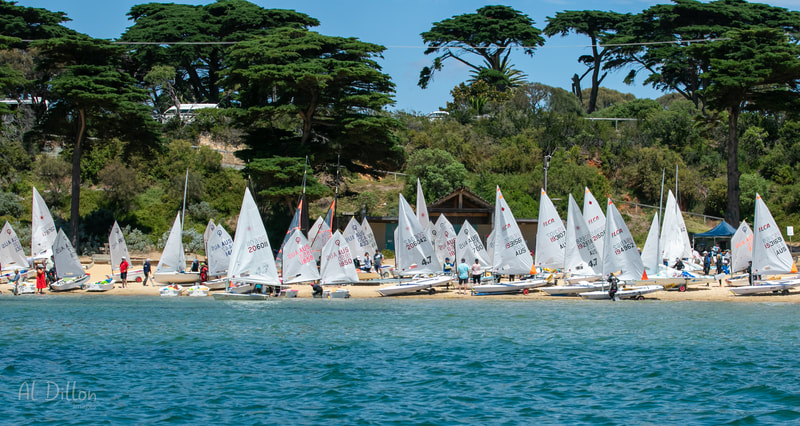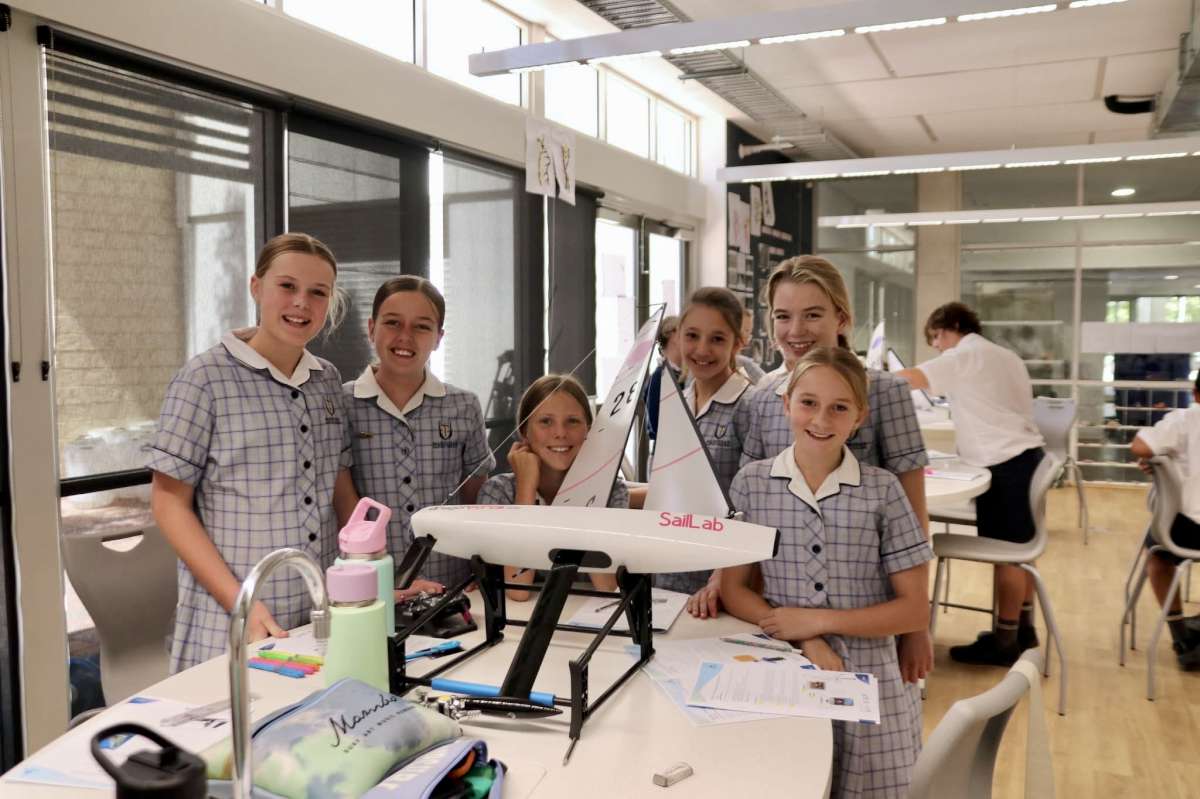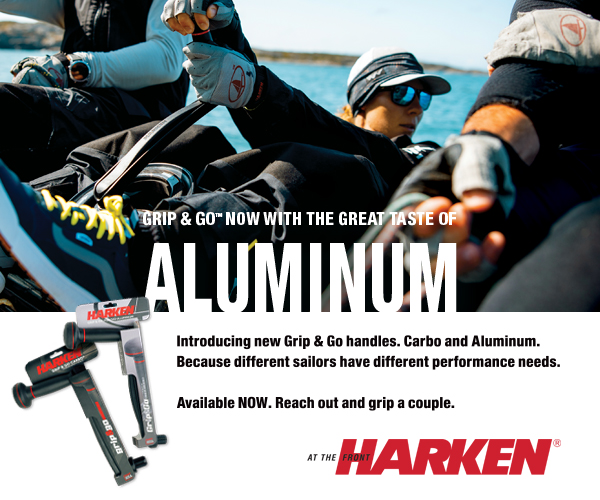Nautor opened in Finland 1966 and quickly gained the reputation of an excellent solid built yacht under the Swan label, which would comfortably and safely take you anywhere in the world. They even won the first Whitbread round the world yacht race.
But, by the 1990s, the high quality of a Swan was undercut by the growth of less expensive, but still excellently-built, high production yacht brands. Until Italian Leonardo Ferragamo entered the scene with the financial backing to totally revamp the Swan brand and reinvigorate the marque.
Under yacht designer German Frers there are three Swan lines now available that incorporate the modern principles of yacht design added with a touch of Italian flair, but all still built with that same Finnish reputation.
The owner of this Swan 48 has opted for some of the racing options to fit out his new yacht. This is the first new Swan to be sold in Australia in many a long year so its introduction may harbour a new wave of interest.
New owner, John Bacon, is an established sailor on the racing circuit here in Sydney. He likes to go fast, so he already has an MC38 for his racing weekends.
However, he also likes to compete in offshore races and here he prefers to mix his racing with a bit more comfort. So, when thinking offshore, Bacon has usually bought cruiser/racers to enjoy both sides of the coin.
Previously he raced a Sydney Yachts 39CR, then he got quite adventurous and purchased a 40 footer for double-handed racing, including the tough Melbourne Osaka yacht race.
After I while he thought, as John puts it, “we were really ready to move back into the cruiser/racer scene.” So he, with steady crew hand David Sampson, began looking at the fifty foot market.
Serendipity took part and, while overseas campaigning his 5.5 metre at the world's in Helsinki, Dave suggested they take the time out and check out the Swan 48 being built at the Nautor Finland factory.
For Bacon, being able to see the actual production process was an eye-opener. By the time he was ready to purchase he had been thinking about the Swan 48 pedigree: ”the more I looked into it the more cool I thought it looked doing club racing.”
He was a little disconcerted when looking to order hull number #9 with no other Swan 48s out on the water to gauge sailability, ”you usually never really know what you are going to get with a new build,” Bacon said, “so you go off the pedigree, which means you end up looking at Nautor Swan and German Frers!”
Considering they are up to 35 hulls sold already and that delivery is pushed out to 2022, Bacon made a smart, early move.
According to Frers the yacht still encapsulates all that Nautor yachts have deemed important. What evolved, says Frers, “rather than acting on a lash of inspiration, this new Nautor model is the result of a rational brief based on market analysis and the experience of the builder, agents and designers.
“The Swan 48 is a new model created by the credible Nautor team offering the best equipment and material specifications and solutions, a quality of construction and equipment dedicated to provide optimal comfort on board.”
The end result, Nautor claims, is a safe and pleasurable yacht to sail, with an easy motion at sea due to her stability and moderate ballast.
Having sailed so many high-performance craft, how does owner Bacon find the Swan? “ Certainly does not feel like a 14 ton boat,” were his immediate thoughts, in other words: “pretty happy!”
On initial test sails they had the Code 0 up in eight knots of true wind and were doing 8kn in boat speed with the apparent wind just 80°. They kept this up when the breeze rose to 10kn, doing 10kn boat speed at 100° apparent.
Bacon and his crew opted for the performance package of the Swan 48, which means a carbon rig and a deep keel. “I don’t need a performance yacht as I have one, but I do want to perform.”
This was my impression also when out for a gentle sail on Sydney Harbour last August. While we did not strike open the Code 0, hard on the wind was still an exhilirating experience. Basically, in under ten knots of true breeze, we could point higher than 35° apparent wind angle and be doing over seven knots boat speed. With each knot of increased wind speed our boat speed would also increase a knot.
Once the wind got over 10kn we could transfer some of that speed into higher attack angle getting closer to 30°. Designed to heel between 10° to 15° the shapely hull drives forward with a gentle sea motion.
Helm ‘feel’ is soft but immediate, there was no fight back. This is a helm that would be perfect for the skipper who likes a yacht that responds, much like a sport boat. Yet, because of this ease of use, it is perfect for the more casual of skippers as well. No need for constant keeping track of your course: where you steer is where you go.
While the Swan 48 of old had a strong reputation as the perfect size to either win you races under the old IOR rating system or take you across oceans in comfort and safety, none of that purpose has been lost with the new design.
But, as Frer’s stated, this is a new design in its own right; utilising the departure from the restrictive IOR with the added bonus of fifty years of progress in yacht hull design. All this progress shows that a fuller volume design gives you beautiful sailability with the added bonus of interior space.
Expansive interior space gives you options to arrange the interior to assist that sailing feel. All heavy equipment and tanks are set below the floor level and along central line to add to an impressive ballast ratio of 1:3.5.
The flat-bottomed torpedo bulb puts the ballast of this boat nearly 50% heavier than a comparable Beneteau Oceanis 51.1; a large difference. The differences in displacement is not so stark at only 10% heavier, but it does mean the Oceanis has a ballast ratio of 1:2.5. The Swan 48 may be comparatively heavy, but it is stiff.
So how does the sail plan offset this to provide such a nice performance? With a 10% taller rig giving 30% larger sail area compared to the 51 footer, that is how. This gives the Swan 48 25% greater sail area to displacement compared to the similarly-sized Oceanis.
The power is there, the safety is inbuilt and then you finish it off with a gentle design from the board of German Frers. By the looks of the profile view, it appears to me to be a shallow canoe body draft for the size, allowing gentle lines runnng fore and aft from the keel. There is a nice curved tuck up into the stern sections running right to the transom.
There are three keel options: standard, shallow and racing, matched to twin rudders with the sail drive set halfway between keel and rudders. The bow thruster is retractable to maintain a smooth hull line.
The mast is well aft to give a J measurement of over 5.5m, providing a large genoa, but also allowing a self-tacking staysail or headsail if you want. This is a good option for heavy weather and short-handed sailing.
But the boom measure is still quite long as well, going right back to the helming stations. There is a genoa and a Code 0, with the addition of the staysail and a gennaker.
This is a big powerful rig but providing plenty of options to give the control needed according to ability. All controlled with standard electric winches to keep it easy for short-handed cruising. Owner Bacon’s racing package includes: deep keel, square top main, carbon fibre mast and boom and rigging and upgraded deck gear.
This is a heavy 48 footer but the feel is of a smoothly sailing hull. Especially in light airs, which seems incongruous. For cruising, nowadays, being able to keep moving in light airs is an important factor, reducing engine use.
On side viewing this is a vastly different Swan profile than the traditional. Gone is the sweeping curves of the old IOR pinched in ends and swollen tumblehome. Thank goodness.
As stated before, this is a design that leans to the success and lessons learned from the bigger sisters: Swan’s 65 and 78. The stem is plumb, countered with a nice slightly-sloped stern. The high topsides are tempered with a low cabin roof languidly sloping fore and aft to the deckline.
A nice black line runs through the middle of the coachroof to reduce its visual height and hide the hatch windows. Teak is standard on the deck and cockpit bench seats and optional for the coachroof. This is a nice call back to the grand Swan era that made extensive use of teak to highlight its quality workmanship.
Movement around the deck is easy with wide side decks for an under 50 footer. The shrouds, from the swept-back spreaders, sit on the slight bulwark at maximum beam.
A lovely addition is the ability to raise and drop the large dodger cover from out of its own cavity forward of the companionway, this makes set up easy while leaving a clean deck otherwise. This dodger is wide covering the width of the coachroof and therefore out to the coaming sides as well, ensuring protection for the crew relaxing on the teak covered cockpit bench seat with their backs to the coachroof.
This follows the premise Nautor has for its yachts regarding the cockpit. The forward section is for relaxing, the mid-section for working the yacht or entertaining sitting around the table; finally the aft section is for steering, but also plenty of space behind to access the fold down stern bathing platform.
Underneath the middle of this aft section is the access to both the tender garage and the steering apparatus.
Bench seat lazarettes are not deep to maintain a good headroom in the aft cabins, which we will get to. Up forward, however, is where the deep storage would normally reside.
The forward deck locker is also a collision bulkhead. It easily holds Code 0 spinnakers, fenders, mooring lines and more, plus includes access to the retractable bow thruster compartment underneath.
To the starboard side of this locker is a smaller anchor chain locker with the offset windlass under the lid and the chain locker glassed in just underneath. It is a tight fit for the windlass against the starboard pulpit stanchions and locker lid, so you would want to make sure the electric motor was working as it might be difficult to use manually. The locker will hold 100 metres of chain.
Looking back down the deck to aft you can see the slight tuck in of the max beam at the transom. Forward of the mast the cabin roof is recessed to allow cushions to be transplanted there for a cosy stare up at the stars when at anchor.
As mentioned, the mast of Cooloola is the racing rig of carbon fibre. It looks sleek and, coupled with the flared boom, together they look sexy. The boom is not a true ‘Park Avenue’ boom you may have seen on old footage of the historic J class yachts but, when dropping the mainsail, it falls quickly and seamlessly into the flared sections without spillage.
You may have already seen a lot of discussion held on the efficacy of the mainsheet system on this design. It is ostensibly a German mainsheet system with the two leads running under the coamings, with the rest of the sheets and halyards, to the winches forward of the steering stations; but it is the aft boom connection that has attracted attention.
Instead of installing a toe-stubbing traveller, Nautor have used a method first seen on the Clubswan 50. Two vertical tubes run down the aft end of the cockpit table taking the mainsheet off the boom end down to a block at the cockpit floor. The idea is it keeps the sheet away from potentially harming crew during manoeuvres.
Much has been said and written about the chafe of the sheet at the top of the pipes when the boom is eased for downhill running. So far there has been no problems on the bigger yachts. I guess the pressure on the sheet is less when running downhill so the chafe pressure is reduced.
Initially it is a neat solution to the dangerous problem of rogue mainsheets flailing in a space where potentially unprepared people are congregating. I certainly saw no problem with them during our test sail.
Maybe, down the track, we might see the tubes being on a swivel and able to lean to port or starboard to more align the sheets when eased. When racing, the cockpit table can be removed but the vertical tubes remain.
Nautor are open to constant feedback to its designs, so having this mainsheet system involved with its racing yachts, the crossover of any changes there would be seen in later designs for other models.
With the space for a 2.8 metre tender crossways in the garage behind the stern swim platform, this also provides excellent access to the steering system under the deck. This area also houses the liferaft.
The steering stations are standalone with plenty of space behind and to the side for the skipper to sail how they feel most comfortable. View through the raised dodger is fine. Anyone walking down the side decks can either enter the cockpit over the coamings, but there is plenty of space behind the skipper to walk around. A split hydraulic backstay provides a good handhold as well as keeping the transom clear for access to the platform.
The two electric winches just forward of the station are difficult to access for the skipper but the buttons are easy to hand. Not an issue.
As mentioned, all the lines come out from under the coamings after disappearing at the base of the mast. All the winches are the same size so no issue with choosing the right one. The halyard and sheet tails can all be dropped into deep rope bins aft of the winches to maintain that sleek look and the safety factor.
This is a design that is ergonomically easy to sail and will eat up the miles while you do so.
Down under
So let us take a look at where the Swan really shines, probably the reason why it is a relatively heavy boat.
At first glance it is like so many other yacht interiors nowadays, but differences are noticeable. It is the quality that is unseen.
Step down a nicely-angled, but deep, five companionway steps to become enveloped in the Swan look. There are three different designs from the designer Misa Poggi: Swan Soul, Scandi Vision and Velvet Vibe. Owner John opted for the most subtle Swan Soul.
No sharp corners here, no large slabs of gleaming white gelcoat. Just the look of a functional, well-constructed layout.
Immediately to port is the galley with its door to the port aft cabin. If the option is taken to make the cabin a lazarette, then the galley would be extended into that space.
To starboard is the main head and shower cabin in front of the starboard aft cabin. Looking straight ahead is the main saloon to port and a bench seat to starboard.
The mast sits against the forward bulkhead, which is the doorway to the main cabin. As stated: standard layout nowadays, so lets get into the detail.
Two large hull windows shine enormous light into the main area, combined with a long overhead twin hatch along the centreline of the cabin roof; plus two slinky windows on the coachroof sides.
The galley also has its own cabintop side window as does the head’s cabin.
At the bottom of the stairs, the galley to port initially looks quite pokey. But it is L-shaped extending aft alongside the stairs.
The stove top is induction, there is no LPG on board. There are various layout options for you with regard to refrigeration. The test boat had a deep, deep freeze with access near the stove top; plus a standard refrigeration unit and another freezer unit underneath. These are both large and capacious.
The sink is along the companionway steps and forms a suitable bench space. The fiddlework is deep and vertical ensuring no nasty accidents in a seaway. There is an insert that can be placed across the entrance of the galley to provide more bench space when required.
With this first visit down below and checking out the galley, it is possibly where you see the thinking behind Nautor’s plan for this model. To my mind, this is a small galley for a 48 foot yacht.
But it bears taking a closer look. Frankly, it is not a small galley, it is just relatively smaller than the ones you see nowadays in other production yachts. Both are built to a purpose, a plan for how the builders see the build being utilised by its owners.
To my mind this is a yacht built with the purpose to be suitable for a couple to take anywhere, two couples at a pinch. Sure it can easily hold six people in comfort but not if that is unnecessary to fulfil your sailing adventure. With that in mind it is not a necessity to have a large galley with expansive storage and gadgets.
It is a clever design brief to plan with. Other yachts of this size work to fit in spacious cabins and workspace for as many people as possible. But why not design for the minimum amount. Look to the market that is likely to purchase a Swan and design to that market.
In most other yachts the port aft cabin would be quite suitable, it is a large bed with plenty of headroom and light. But it is the starboard aft cabin that stands out.
Blessed with the extra space, Frers has extended the cabin berth to be behind the engine room and under the cockpit floor. So what you get is two single beds with an aisle between.
Stick in the special insert, however, to join the two together and you get a massive double bed for your guests to really enjoy their cruise.
All without losing space in the engine room behind the companionway steps. There is even the space for the generator to fit in behind the 55 kw Volvo engine.
Yet this area is still easily accessible to do maintenance work, there is a half metre of headroom above the engine. By the way, it runs off a massive 360 litre fuel tank to give you approximately 90 hours of cruising motoring.
Enter the main saloon head and shower cabin and the space here is limited. The toilet itself is along the hull against the back wall. There is a sink and a separate shower recess. The elbow room is okay but not generous. I also found the closing shower doors a bit flimsy. There is a good size ventilation hatch overhead.
The main U-shaped saloon area seats four easy and will take six. Or the other two can sit on the starboard side settee. There are various options here but I do like this version: nice surrounding cushions; each seat with a lifting lid access into the navigation table; overhead bins; beautiful big hull porthole; all the instrumentation and electrics. This would be the most-used spot in the house I reckon, whether reading, relaxing or working.
Moving forward into the main cabin entrance offset to starboard and it is fairly straightforward here. Large double bed with some side access, hanging locker and storage drawers to starboard and the head and shower cabin to port.
Apparently the designers wanted to have the bed on hydraulic struts to access storage underneath, but the Nautor builders countered that is not good enough and inserted large pull out drawers.
The head and shower cabin is most likely the same size as the main cabin. The toilet faces forward with plenty of knee room in front. The shower recess uses the same doors as the other and has adequate elbow room.
All in all this is a neatly laid out interior plan. As stated at the start, it is not so much the layout as the construction: this is all proper wood, proper joinery work and finished off.
The proof of just how much effort is put into the interior is something you cannot see. All the mouldings, such as cupboards and seating etcetera are joined to the hull, not glassed-in modules.
The hull sides are covered in a fabric that is permeable. This is designed to allow two things: it is easy to access all the electrics, piping and through hulls and deck fittings running through the hull; plus, every Swan build has passive through-ventilation to allow the passage of air around the yacht to stop condensation.
This constant internal ventilation, throughout all cabins, compartments and bilges, is invisible but ensures good airflow throughout the yacht even when locked up. The permeable hull liners facilitate this ‘breathing’; it stops humidity build up and condensation that leads to unhealthy, sweaty interiors.
Each Swan 48 hull is built as a single hull in vinylester with a closed cell foam core and gelcoat finish. The hull support frame structure is installed in one piece to ensure correct load bearing and stiffening against torsional forces. The hull frame is used to deliver any service piping or wiring throughout. The keelbolt backing plate is a part of this web structure.
Owner John Bacon bought Cooloola sight unseen as hull number #9. There were sixteen hulls sold before one was even put on display. This is the third design version of the Swan 48 since it first appeared in 1971 and became a best seller. Looking forward to seeing more of this classic yacht in the years to come.
Both John and his partner grew up on the Australian east coast between Noosa and Fraser Island; they were looking for a boat name that recalled those memories. Cooloola is an area within the Great Sandy National Park south of the Great Sandy Strait. The word is indigenous to the Gubbi Gubbi people and means ‘the sound of the wind through the native she-oaks’.
Is this the sort of wind that helps a swan to soar?






